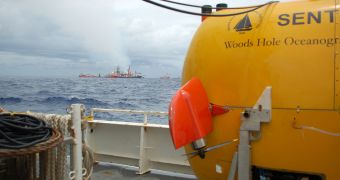A group of experts analyzing the area around the BP Deepwater Horizon oil spill site discovered a massive underwater hydrocarbon plume lurking below the waves.
The work, which was funded by US National Science Foundation (NSF) and was affiliated with the Woods Hole Oceanographic Institution (WHOI), discovered the plume some 3,000 feet (914 meters) below the surface of the Gulf of Mexico.
According to the investigators, the structure is 650 feet high, 1.2 miles wide and 22 miles long. It was found during a research effort conducted between June 19 and 28, near the site of the initial accident.
Researchers have known for some time that the oil which spilled from the wellhead did not disappear into thin air. As the surface sheens and slick disappear, experts are looking for where the bulk of the contaminant is.
“These results create a clearer picture of where the oil is in the Gulf,” explains WHOI marine geochemist Christopher Reddy, who was a part of the investigation.
He is also one of the authors of a new paper detailing the findings, which appears in the August 20 issue of the esteemed journal Science.
Funds for the investigation were secured through three rapid response grants, awarded by the NSF via its Chemical Oceanography program.
Additional funding was provided by the US Coast Guard (USCG), and the National Oceanic and Atmospheric Administration (NOAA), through the Natural Resource Damage Assessment program.
After analyzing the rate at which microbial lifeforms were degrading the underwater hydrocarbon plume, the research team established that the process will not be swift, and that a relatively long period of time will pass until the dangerous chemicals are disintegrated.
“These findings confirm what NOAA and our federal partners have reported about the presence and concentration of subsurface oil, and provide an additional piece of the puzzle as we continue to aggressively monitor the fate of the oil in the Gulf,” explains Steve Murawski.
“Our collaborations with Woods Hole and other academic and private research institutions are critical to the ongoing response and recovery efforts,” adds the expert, who is NOAA's chief scientist.
“This research illustrates the value of NSF's long-term investment in state-of-the-art technology like Sentry so that it can be deployed not only to advance basic knowledge but also in national emergencies,” concludes the director of NSF Division of Ocean Sciences, David Conover.

 14 DAY TRIAL //
14 DAY TRIAL //